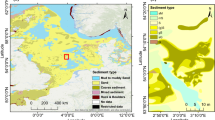Abstract
The observed hydrographic surveying data from multibeam echosounder system (MBES) contains sounding and backscatter intensity data that can be utilized in many coastal and marine applications such as marine geological and environmental investigations. In this paper, the seabed sediments map** for Sharm Obhur (Obhur Creek) was derived using backscatter intensity data. The backscatter data were radiometrically and geometrically corrected to produce a seabed backscatter mosaic for Sharm Obhur study area. Then, the angular response analysis was implemented to derive the seabed sediment’s grain size, classification (gravel, sand and mud) and associated confidence level values that identify the quality of the classification method implemented in this paper. It was shown that the mouth in the south of the Sharm Obhur mainly contains sand sediments, however, the north side of the Sharm Obhur contains mud sediments and gravel sediments can be seen in very small areas. Moreover, it was found that the successful rate of classification is 90% based on the estimated confidence values. To validate the derived seabed sedimentation map, a comparison was made between the grab sampling results reported in the literature and the seabed sediments types derived in this paper. The comparison showed that the derived seabed sediments results using angular response model agree with the grab sampling results. The advantage of map** the seabed sedimentation using multibeam backscatter data over the grab sampling method is that it can provide the seabed sediment map** for the entire area using the MBES due to its 100% coverage of the seabed.









Similar content being viewed by others
References
Amiri-Simkooei AR, Koop L, van der Reijden KJ, Snellen M, Simons DG (2019) Seafloor characterization using multibeam echosounder backscatter data: methodology and results in the North Sea. Geosciences 9:292
APL (1994) High-frequency ocean environmental acoustic models handbook (APL-UW TR 9407). Applied Physics Laboratory, University of Washington, Seattle
APL (2000) High-frequency bistatic scattering model for elastic seafloors. Applied Physics Laboratory University of Washington, Seattle
Basaham AS, Rifaat AE, El Sayed MA, Rasul N (2006) Sharm Obhur: environmental consequences of 20 years of uncontrolled coastal urbanization. J King Abdulaziz Univ Marine Sci 17:129–152
CARIS (2017) Training manual: backscatter imagery data processing CARIS HIPS and SIPS professional 10.4. Teledyne CARIS, Inc., Fredericton, Canada
Che Hasan R, Ierodiaconou D, Laurenson L (2012) Combining angular response classification and backscatter imagery segmentation for benthic biological habitat map**. Estuar Coast Shelf Sci 97:1–9
Dufek T (2012) Backscatter analysis of multibeam sonar data in the area of the Valdivia Fracture Zone using GEOCODER in CARIS HIPS&SIPS and IVS3D Fledermaus. Master Thesis, Hafen City Universität Hamburg
Feldens P, Schulze I, Papenmeier S, Schönke M, Schneider von Deimling J (2018) Improved interpretation of marine sedimentary environments using multi-frequency multibeam backscatter data. Geosciences 2018(8):214
Fonseca L, Mayer L (2007) Remote estimation of surficial seafloor properties through the application Angular Range Analysis to multibeam sonar data. Mar Geophys Res 28:119–126
Gheith A, Hariri M (2010) Assessment of marine ecosystem degradation based on studying the geological significances of bottom sediments in Sharm Obhur, North Jeddah, Saudi Arabia. JKAU: Mar Sci 21(2):89–108
Hellequin L, Lunton X, Augustin JM (1997) Postprocessing and signal corrections for multibeam echosounder images. OCEANS’97 MTS/IEEE Conf Proc 21:23–26
Huang Z, Siwabessy J, Nichol S, Anderson T, Brooke B (2013) Predictive map** of seabed cover types using angular response curves of multibeam backscatter data: testing different feature analysis approaches. Cont Shelf Res 61–62:12–22
Hughes Clarke JE, Danforth BW, Valentine P (1997) Areal seabed classification using backscatter angular response at 95 kHz. In: NATO SACLANTCEN Conference Proceedings Series CP-45, high frequency acoustics in shallow water: pp 243–250
Ierodiaconou D, Monk J, Rattray A, Laurenson L, Versace VL (2011) Comparison of automated classification techniques for predicting benthic biological communities using hydroacoustics and video observations. Continent Shelf Res 31:S28eS38
Jackson DR, Briggs KB (1992) High-frequency bottom backscattering: roughness vs. sediment volume scattering. J Acoust Soc Am 92:962–977
Lamarche G, Lurton X (2018) Recommendations for improved and coherent acquisition and processing of backscatter data from seafloor-map** sonars. Marine Geophys Res 39:5. https://doi.org/10.1007/s11001-017-9315-6
Lamarche G, Lurton X, Verdier A-L, Augustin J-M (2011) Quantitative characterization of seafloor substrate and bedforms using advanced processing of multibeam backscatter. Application to the Cook Strait, New Zealand. Cont Shelf Res 31(2 SUPPL):93–109
Le Bas TP, Huvenne VAI (2009) Acquisition and processing of backscatter data for habitat map**—comparison of multibeam and sidescan systems. Appl Acoust 70:1248–1257
Lucieer V, Hill NA, Barrett NS, Nichol S (2013) Do marine substrates ‘look’ and ‘sound’ the same? Supervised classification of multibeam acoustic data using autonomous underwater vehicle images. Estuar Coast Shelf Sci 117:94–106
Lurton X (2010) An introduction to underwater acoustics—principles and application, 2nd edn. Springer, Berlin
Lurton X, Lamarche G (eds) (2015) Backscatter measurements by seafloor-map** sonars. Guidelines and recommendations. vol Geohab Report. http://geohab.org/publications/. Accessed 30 Sep 2019
Marsh I, Brown C (2009) Neural network classification of multibeam backscatter and bathymetry data from Stanton Bank (Area IV). Appl Acoust 70:1269–1276
Acknowledgements
This work was supported by the Deanship of Scientific Research (DSR), King Abdulaziz University, Jeddah, Saudi Arabia. The author, therefore, acknowledges with thanks DSR technical and financial support. In addition, many thanks to Abdullah Shaheen and Abdullah Alamoudy for their help in this manuscript.
Author information
Authors and Affiliations
Corresponding author
Additional information
Publisher's Note
Springer Nature remains neutral with regard to jurisdictional claims in published maps and institutional affiliations.
Rights and permissions
About this article
Cite this article
El-Diasty, M. Map** seabed sediments for Sharm Obhur using multibeam echosounder backscatter data. Model. Earth Syst. Environ. 6, 163–171 (2020). https://doi.org/10.1007/s40808-019-00668-x
Received:
Accepted:
Published:
Issue Date:
DOI: https://doi.org/10.1007/s40808-019-00668-x




